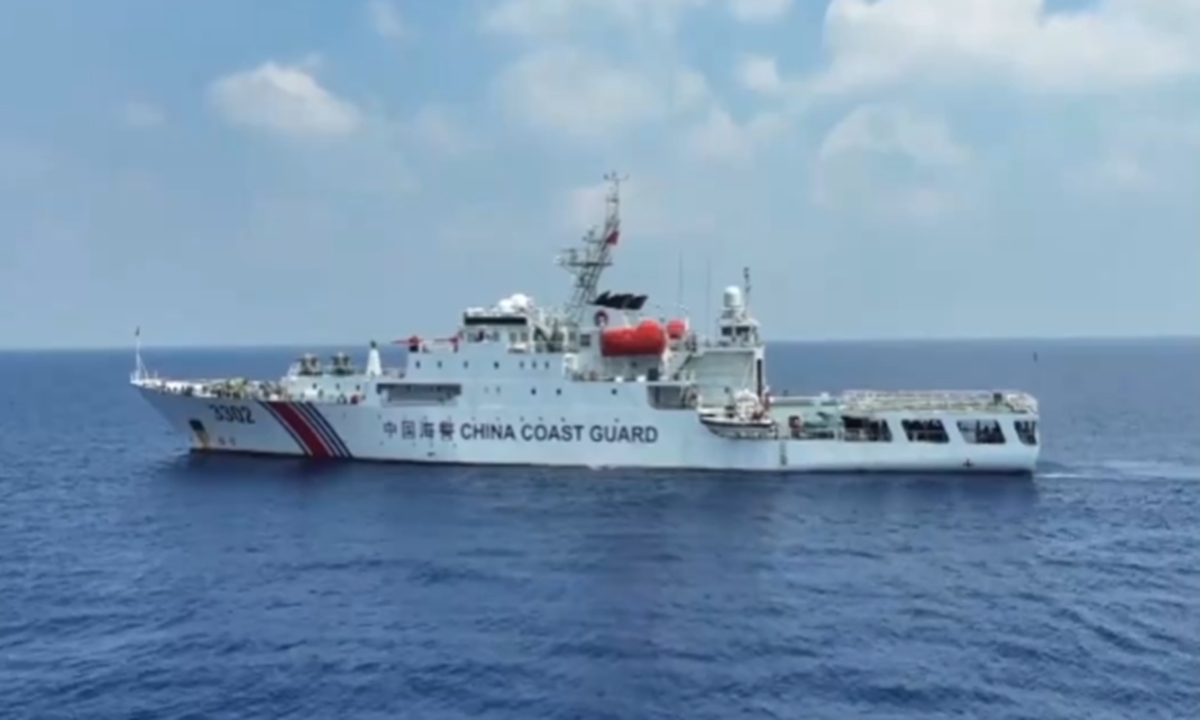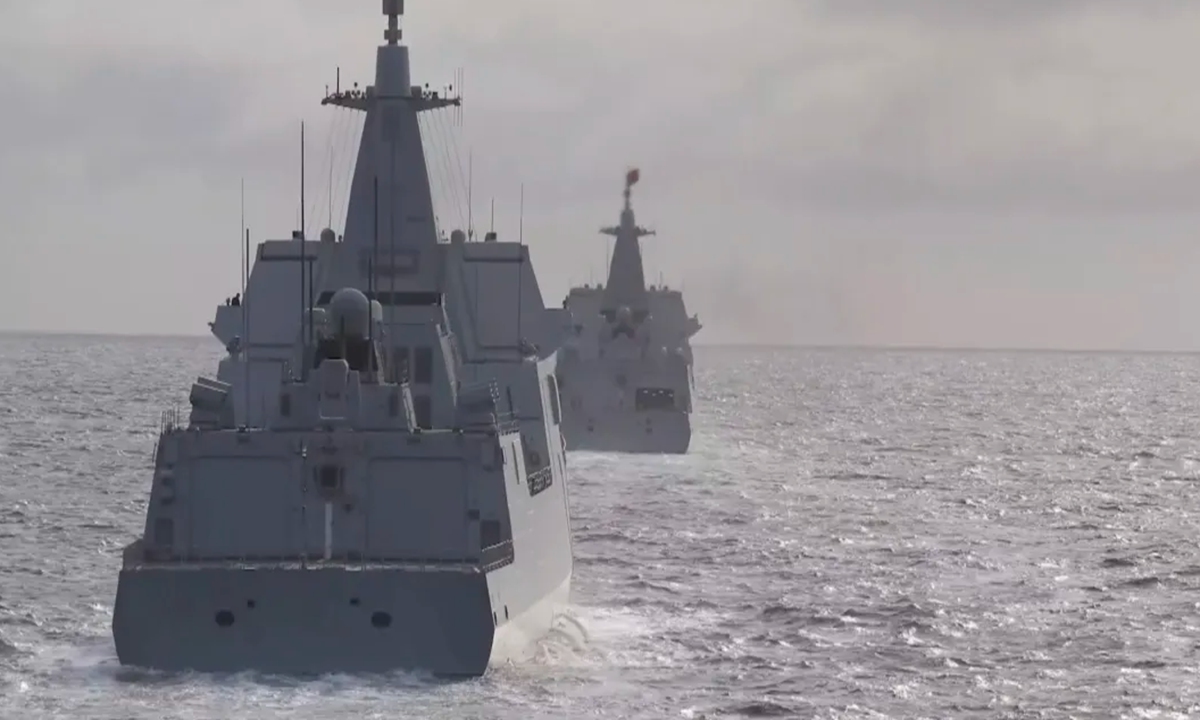
China Coast Guard Ship Chuanshan (Hull 3302) conducts maritime rescue exercise in waters adjacent to Huangyan Dao (also known as Huangyan Island) in the South China Sea in early summer of, 2024. Photo: Screenshot from media reports
China is well prepared for the Philippines' latest attempt to legalize its illegal occupations in the South China Sea as Manila recently filed a claim with the UN about an "extended continental shelf" (ECS) in the region, said analysts, noting that China will take comprehensive countermeasures in all fronts to safeguard its territorial sovereignty and maritime rights, and that the China Coast Guard's (CCG) new procedures will allow Chinese law enforcement forces to take more decisive action to counter provocations.
Marshall Louis Alferez, foreign ministry assistant secretary for maritime and ocean affairs, said in a statement that "Today we secure our future by making a manifestation of our exclusive right to explore and exploit natural resources in our ECS entitlement," Reuters reported on Saturday.
According to the relevant provisions of the continental shelf section of the UN Convention on the Law of the Sea, under certain conditions, the continental shelf of a coastal state can extend beyond 200 nautical miles from the territorial sea baseline.
The Philippines has mainly based its application to the Commission on the Limits of the Continental Shelf on this provision to determine the outer limits of the continental shelf beyond 200 nautical miles, said experts.
Unlikely to be reviewed
Ding Duo, deputy director of the Institute of Maritime Law and Policy at the National Institute for South China Sea Studies, told the Global Times on Sunday that according to information from the Philippine Department of Foreign Affairs, the so-called "outer continental shelf in the South China Sea" in the West Palawan region overlaps with waters under Chinese jurisdiction claimed by China."
In the case of such disputes, according to the rules of procedure of the Commission on the Limits of the Continental Shelf, the submission is unlikely to be reviewed and may be postponed for review, Ding said.
The main purpose of the Philippines in submitting the outer limits of continental shelf case is to legitimize the illegal ruling of the South China Sea arbitration case.
Additionally, it aims to provoke attacks and defamation against China's South China Sea policies and positions in international multilateral forums and the global public opinion arena, experts said. Considering that the Philippines has illegally occupied several islands and reefs of China's Nansha Qundao (also known as Nansha Islands) and recently caused incidents at Xianbin Jiao and Tiexian Jiao, the Philippines is attempting to use the outer continental shelf card to whitewash, solidify, and even expand its illegal gains in the South China Sea, they noted.
The Philippines has long been plotting this move, supported by American research institutions and legal teams, said analysts.
Over the past few years, they have been making legal and technical preparations. However, China is prepared for this and will respond diplomatically and politically to demonstrate its stern stance. China will also take corresponding countermeasures based on the actual needs to safeguard its territorial sovereignty and maritime rights, while continuing to expose the real intentions and malicious purposes of the Philippines' continuous infringement and provocations to the international community, Ding noted.
The Philippines' continued hype over the administrative enforcement procedures of the CCG reflects its guilty conscience and shows the intention for self-promotion through hype, Ding said.
Regardless of how the Philippines misleads, distorts, and defames the new regulations of the CCG in the international public opinion arena, the CCG will continue to take effective and professional rights protection enforcement measures against the Philippines' infringement and provocations in the South China Sea, firmly safeguarding China's territorial sovereignty and maritime rights, said experts.
Ready to counter provocations
The Chinese People's Liberation Army (PLA) Navy reportedly has for the first time deployed an amphibious assault ship to the Nansha Qundao in the South China Sea, a move experts said on Sunday is preparation for any emergency response amid repeated provocations by the Philippines.
China's Type 075 landing helicopter dock, also known as amphibious assault ship, was spotted near Zhubi Jiao (also known as Zhubi Reef) on Friday, marking its first deployment to the Nansha Qundao in the South China Sea, the Manila Times reported on Saturday.
The reported maiden mission on the Type 075 amphibious assault ship came shortly after another main amphibious warship of the PLA Navy, a Type 071 amphibious landing ship, for the first time hosted hovercraft drills near Xianbin Jiao (also known as Xianbin Reef) in the Nansha Qundao on June 4, according to a June 7 report by the Philippine Daily Inquirer.
Philippine media quickly linked the PLA Navy's warship deployment to the CCG's latest administrative law enforcement procedures, which took effect on Saturday.
But observers pointed out that it is the Philippines that has engaged in continuous provocations against the Chinese islands and reefs in the first place, and the Philippines is acting like a thief crying "stop thief."
In a recent incident, the Philippine coast guard dispatched boats to illegally land on islets of Xianbin Jiao, which met with CCG restrictive measures; another recent incident involved Philippine personnel stationed aboard its warship illegally grounded on Ren'ai Jiao (also known as Ren'ai Reef) pointing guns at CCG vessels.
Around the day of the implementation of the CCG's new procedures on Saturday, the Philippine coast guard sent vessels to both Xianbin Jiao and Huangyan Dao (also known as Huangyan Island), according to open-source intelligence data gathered by Chinese technology and intelligence company MizarVision on Friday and Saturday.
The Philippines could be testing China's new changes following the implementation of the CCG's new procedures, analysts said.
It is totally legitimate for the PLA Navy to conduct training exercises on and near Chinese islands and reefs in the South China Sea, a Chinese military expert who requested anonymity told the Global Times on Sunday.
The drills contribute to the PLA Navy's capabilities in safeguarding China's territorial sovereignty and maritime rights, the expert said, noting that the presence of some of China's main amphibious warfare vessels will ensure any potential emergency will not lead to worse scenarios.
The Chinese side remains highly vigilant and will continue to take all necessary countermeasures against the dangerous, escalatory acts by the Philippine side, said Zhang Xiaogang, a spokesperson for China's Ministry of National Defense, in a regular press release on Friday on the recent incidents in the Nansha Qundao.



